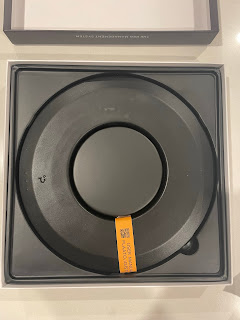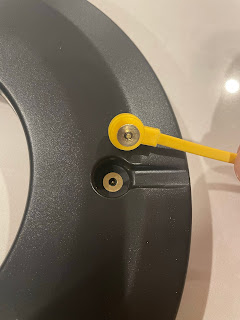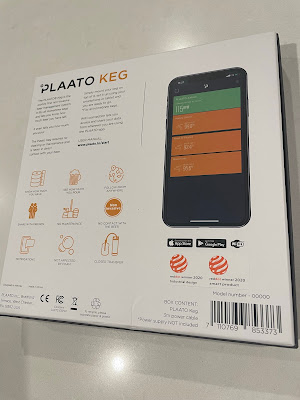Kegging your beer has plenty of advantages - in many ways it's quicker and easier than using the traditional method of bottling, but it does have some disadvantages too. One of those is the inability to accurately determine exactly how much beer you have left in your keg. Sure, you can pick it up to see how much it weighs which will give you some indication, but we've certainly been faced with the situation of a keg that feels like it's completely empty, but keeps pouring beer! Sure, that doesn't sound like such a terrible thing, unless you're trying to empty a keg so you can fill it with a new batch.
When it comes to accurately determining the remaining volume of a keg - your options are somewhat limited. There are crude and basic solutions such as a magnetised ball that sits inside the keg, floating on top of the beer that maintains a magnetic connection to an indicator on the outside of the keg to show the current level. There are also options involving complicated and expensive flow meters that seem messy and introduce a possible source of leaks and contamination for your keg system.
 |
| Plaato Keg Box |
Plaato Inc recognised this gap in the market and came up with an incredibly clever and unobtrusive solution to the problem with their Plaato Keg product - initially created and funded by a Kickstarter Project back in 2019.
Plaato Keg is essentially a Wi-Fi connected scale that weighs your keg in real time. Using some clever calculations behind the scenes such as temperature, empty keg weight and the ABV (alcohol by volume) of the beer inside, it determines exactly how much beer is left in your keg. This is all reported in real time back to an app that can even send you a push notification on how much beer was contained in your last pour. Pretty cool, right? We thought so, so we bought one.
We ordered ours directly from the Plaato website which was offering free world wide shipping at the time of purchase. It took just under two weeks to arrive at our address in Metropolitan Sydney (Australia).
The packaging is minimal - coming in a simple square box with the circular scales surrounded by a plastic housing, and the included yellow USB cable underneath. No hard copy instructions were included either, which is pretty much the norm these days - just a link to the online user manual via URL or QR code. But who needs instructions anyway, right?
 |
| Plaato Keg unboxing |
The scales themselves are made of black plastic and feel very sturdy. The design is very minimalistic - with three white LED indicator lights and the USB charging port the only details on the top side. The bottom side features three accelerometers which are used to determine the weight on the scales based on how much force is exerted on them.
One early criticism is the lack of a power adapter for the USB cable required to power the Plaato Keg. Most customers wouldn't be powering this from a standard computer USB port, so will need to source a USB type A compatible power adapter with a minimum power rating of 5V and 2 Amps. Admittedly these aren't difficult to come by, but will no doubt catch some customers out who may not be able to use their Plaato Keg until they get an appropriate adapter which would be frustrating. We suspect the reason for not including the power adapter is firstly, to minimise manufacturing costs, and secondly, to simplify distribution since every packaged product will be exactly the same since it doesn't include any country/regional specific hardware such as a power adapter.
The included USB cable has plenty of length though, being 3m in total which is generous and should be more than sufficient for most applications. The cable is also flat, meaning it can easily be fed through the door opening of your fridge/freezer kegerator without causing a large gap in the seal and thus impacting (reducing) it's cooling efficiency. The end of the cable that connects to the Plaato Keg base is magnetised and has a dedicated channel to sit in as it passes over the Plaato Keg body. This makes connecting a breeze and minimises the risk of the connection coming loose or the cable being pinched and damaged from a keg sitting on it. There's a lot of little details like these that make the product feel well engineered and thought out.
 |
| The USB cable connection to the Plaato Keg base is magnetised meaning it won't easily come loose or disconnect |
Before starting, we downloaded the free Plaato app from the Apple App Store and created an account with our email address. This was relatively painless but an option to create an account and authenticate using an existing account/authentication provider such as Google, Facebook, Microsoft etc wouldn't go astray. Setting up standalone accounts like this just means it's one more account password we need to try and remember.
We then connected the USB cable to our power adapter, then to the Plaato Keg body which immediately puts it into setup mode, indicated by the three white LED's on the scales flashing.
 |
| Three flashing white LED's indicate the Plaato Keg is in setup mode |
Back to the app and we're walked through the process of entering our Wi-Fi network name (SSID) and password. We then connect to the Plaato Keg directly using it's own captive portal where the app then configures it with our Wi-Fi network details to allow it to connect to the network as well. This process was really straight forward and explained clearly by the app at each step of the process and only took a minute or so to completely setup.
It's also worth pointing out that the Plaato Keg will only work on a 2.4GHz wireless network so you need to make sure this is enabled on your home Wi-Fi modem/router.
 |
| Sample screenshot at the end of configuring the Plaato Keg. The app did a great job of walking through the process making it incredibly easy |
Once the setup is completed we're prompted for a name for our Plaato Keg - we opted for the default but this can very easily be changed at any time from within the app. Naming would be a little more important if you had multiple Plaato Kegs setup - which can be done and all managed from within the app.
From the main app screen, we select our Plaato Keg which takes us into the properties for that particular device. From here we have four pages - Monitor, Keg Setup, Settings and Debug
The Monitor page, as the name suggests is where you can view the key stats for your keg. It features a beer left value (volume or weight), a pour indicator, last pour volume, gravity values that can be entered to determine ABV, temperature and user configurable Beer Style and Keg Date text fields. At the very bottom we've got a graph (not yet visible as there's no data) showing latest pours and total beer volumes and temperature
 |
| Plaato Keg app - Monitor page |
Moving onto the Keg Setup page and from here we can set specific parameters for the keg that we're going to put on the Plaato Keg scales. We can 'zero' out the scales using the large green Tare button, and also enter the empty keg weight. Most wouldn't know what their empty keg weighs, so if you happen to have an empty one laying around (of the same make/model) you can put it on and it will tell you the weight. Neat. We didn't have an empty one laying around so we've entered an approximate value based on a quick google search. Obviously the more accurate this information is that you enter, the more accurate the readings from the Plaato Keg will be, so it's probably an idea to also include the liquid/gas disconnects when weighing it empty. You also set the maximum keg volume which is what is used to generate the percentage values for how empty/full the measured keg is.
At the bottom of this page, you can enter values for original and final gravities which can then be used by the app to calculate the ABV of the corresponding beer, or you can just enter the ABV manually if you already know what it is. Once again, this is used to help determine the weight and volume of the beer in your keg. On the left hand side we have a yellow bar indicating the percentage value of the keg. In the example below, we've got 22% remaining in the keg.
 |
| Plaato Keg App - Keg Setup page |
On the Settings page, we can specify other options for how the Plaato Keg will work. Settings such Metric or US (imperial) measurements, and whether the measured keg values should be returned in weight or volume. You can also switch the app to measure how much CO2 you have left in your gas bottle which is a handy additional feature.
You can also specify the scale sensitivity here - there's not alot of information on exactly what this achieves, but it appears to be a feature to reduce the occurence of 'ghost pours' - where the app reports beer being poured when it is not. We set ours to Medium.
 |
| An example pour push notification from the Plaato app |
Push notifications are the last section of configurable items on this page, where you can enable push notifications for pours (where it will generate a notification advising how much volume was contained in the last pour), liquid detection (ie. if the Plaato Keg detects moisture indicating a potential leak from your keg), temperature and nearly empty warnings.
 |
| Plaato Keg App - Settings page |
The last page is Debug, which allows you to view more detailed information for troubleshooting such as calibration info (lean/slope angle, offset). You can also perform advanced calibration by entering a known weight into the appropriate text box and set temperature offset correction. Finally at the bottom, we can see Wi-Fi signal strength and the current firmware version.
 |
| Plaato App - Debug page |
We're pretty impressed so far with our Plaato Keg experience. The whole product and associated experience is very well polished - making for an easy to use and effective experience from start to finish. The unobtrusive nature of the product means it can be integrated seemlessly into your existing keg setup with minimal disruption. No need to re-route beer lines or mess about with flow meters - just set your keg on the scales and away you go. It was this simplicity that drew us to the Plaato Keg in the first place. We're currently running a dual keg setup so will definitely be looking into purchasing an additional Plaato Keg in the future so we can measure both kegs in real-time.
 |
| Our 19L corny keg sitting on the Plaato Keg |
Our only complaints are only very minor - the previously mentioned lack of USB power adapter is unlikely to change, but potentially simplifying the registration and sign in process to integrate with authentication providers like Facebook, Google and Microsoft (so you could register and sign in with your gmail.com account for example) would be a great enhancement.
The mobile app is excellent - with a neat, intuitive interface with just the right balance of information, settings and options. There's plenty there, but it doesn't feel overwhelming, and you can easily find what you're after by navigating between the four pages within your Plaato Keg. The guided setup through the app was flawless as well, providing clear and simple instructions that were easy to follow.
The Plaato keg still utilises relatively old 2.4GHz wireless technology, however, this older style of Wi-Fi is known to have better range meaning it's probably very much a requirement when we're talking about putting a Wi-Fi enabled device inside a fridge/freezer/kegerator, often in a remote part of the house such as a garage that may not typically have the strongest of Wi-Fi signals.
There has also been a recent integration to allow Plaato Keg readings to be fed into Taplist.io - so your keg volumes can be sync'd/updated to your Taplist.io digital menu/tap list. Check out our blog post covering this cool feature.
 |
| Plaato Keg - back side of box |
The Plaato Keg is not a critical requirement for a homebrew keg setup, but it's certainly a clever and helpful bit of equipment that can help brewers manage their kegs and keep track of things. Additional features like the ability to weigh CO2 cylinders only help to enhance the experience and show the designers and developers at Plaato have really thought this through. Another excellent use case for something like this would be to measure kegs when filling (if using closed loop transfers like we do) to take the guess work out of things.
We'd highly recommend the Plaato Keg to anyone looking for a reliable, unobtrusive and easy way of measuring and keeping track of their keg volumes.


No comments:
Post a Comment